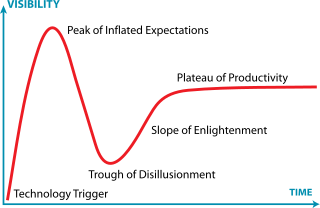TL;42
Early adoption can be a double-edged sword: it may give you a competitive edge, but also bring challenges and risks that are not really worthwhile. Choosing the right tech for your website requires weighing pros and cons, because sometimes boring is best.
The next big thing is a million little things
Allow me a brief and geeky walk down memory lane. It will only take a minute. Two, actually. I counted.
I’m not that old but I’m old enough.
When I started making websites, twenty years ago, it was as simple as adding some quirky code into a notepad and pushing it to a server. I wanted a Blackberry. iPhones didn’t exist yet. Google Analytics came along and data became available and powerful. I moved on to building my first eCommerce websites on Netsuite’s appalling “Website Builder” using the already-outdated ugly html tables and jumping through hoops to deliver a basic shopping experience.
Then, Adobe delivered Flex with its superpowers, followed by Adobe Air’s magical transitions that seemed to come straight from the future. None of them lasted long. By 2010, SaaS was completely mainstream and I was a proud Certified Partner of two promising startups called BigCommerce and Mailchimp.
2010. Rihanna spent fourteen weeks as #1.
Fireworks changed the way agencies designed. Marcotte’s Responsive Design & Media Queries were mind blowing. CSS Zen Garden had stuff worthy of MoMA. Ruby on Rails was the best thing on earth until it wasn’t (though probably it still is). Atomic design became a thing and so did a lot of smarter tools for user experience, usability and behavior analysis.
The mid 2010s saw the rise and dominance of Javascript frameworks. Angular, React, Vue and the rest took the reins.
Somewhere in the middle of then and now.
Then something odd happened. The web development craft changed from pushing the possibilities of one-to-one brand experience to a nightmarish entanglement of code dependencies, frameworks, languages, package managers, version incompatibilities, APIs, middlewares and unbearable crap everywhere. If you were in a leadership position back then you probably got one or ten bills and had to pay for the aftermath.
Most of us in the business were exhausted. The industry called it “Javascript fatigue”. I have stronger words for it. But like with most things, time passed, and so did the turmoil. The next generation of tech folks never knew the good and easy days so they didn’t care, and the rest of us learned to adapt. The mess became documented, and the chaotic patchwork quilt evolved into fancier concepts like Composable Commerce, Headless, and Omnichannel.
Now we have SaaS fatigue.
Our lovely motto is “the next big thing is a million little things”. It implies two distinct, contradictory, thrilling ideas:
- We live extraordinary times with tailored, endless combinations of best-of-breed tools that, when stitched together gracefully, deliver magnificent experiences (that make money). And it’s beautiful.
- Nothing is one single easy thing anymore. Digital experiences are made of a constellation of complex tools hung by threads. Everything is broken most of the time. And it’s overwhelming.
- There’s always so much to choose from. And cool features seen in competitors. And plenty of novelty. Shiny, cool stuff.
Is it worth it, though?
Pros and cons of early adoption
Let’s go through the obvious upsides
Brand new tools, platforms or services come with some very appealing upsides:
Cost savings.
The new kids on the block always look for new case studies, market reach, and testing product-market fit. In most cases, this translates into a more favorable price or deal flexibility than what you’d expect from more mature market leaders. Keep in mind this only works for a while. At some point, pricing will catch up with reality and the impact is big.
Competitive advantage.
Embracing cutting edge technology – or new and more modern versions of already established tools – can put your brand and customer experience ahead of the competition.
Leading innovation.
Hitting first and hitting twice. Pioneering creates a problem for the other industry players and forces them to play catch-up.
That’s all good. There’s a flip to that coin though.
All that glitters is not gold
Disrupting technology often comes from new, emerging companies. And comes with conflicts and contradictions. These are never shown in demos or advertised in brochures. They’re carefully disguised (sometimes as features!) and even our BFFs at procurement fail to spot them. Until they bite midway through the project:
Lack of documentation and a mature ecosystem.
Back to the million little things. If all the moving pieces in your tech stack are interconnected, those bridges should ideally pass the test of stress and time. New platforms often lack solid connections or strong development documentation.
Pressure to put business ahead of product.
This applies to startups, more than to bootstrapped independent businesses. Companies looking for money injection and fast growth must achieve certain milestones on their blitzscaled way up. While this creates an ambitious culture and sticky phrases like listen hard, change fast, break things, the truth is things do actually break. Releases are rushed for the benefit of the narrative and market positioning.
Unclear ambitions, stakeholders and exit strategies.
One of our favorite clients has consistently been on the front of early adoption and innovation for nearly four decades. He always asks new providers the same thing: Can you get me a meeting with a C-level person who can look me in the eye and tell me the platform will still be there in five years?
Startups are born brands and products, and at some point, evolve into companies. In the meantime, they float in a state of permanent transition. Only time tells in transition to what.
We’ve been part of expensive projects where companies like yours put their time, effort, money and stress, only to find they need to change or replatform again soon. Or worse: You’re stuck into a contract and playing the sunk cost game.
What it is
All these pros and cons are generalizations, of course. There are plenty of companies that started their journey with a strong focus on operations, culture, and utmost respect for their product and ecosystem (37Signals always comes to mind) and time proved them right once and again.
Signing a contract with a new SaaS or tech solution is flipping a coin.
It might just be perfect. Yet these downsides have risk written all over.
How to get better at spotting them, that is the question.

The wisdom to know the difference
You come across a new tool. Through a digital campaign, a webinar, a conference, or one of the endless outreach emails you get every day. It looks like it could be very attractive for your company, provided it can fulfill its promise.
If the product, pricing and competitive edge fit, go for it. Taking risks is part of business. Just make sure you challenge it against three things:
The pressure of change
We’re halfway through a decade of massive changes in B2B sales, most of them driven by tech adoption and accelerated by the dreadful 2020 events. There are internal forces (stakeholders, performance, impressing new bosses) as well as external ones (competition, tech falling behind, new channels and so on) that put additional pressure to bring something new.
Are we buying new technology because it’s right, or because we’re forced to?

The Hype Cycle
While Gartner’s Hype Cycle is often criticized for not being scientifically accurate, it’s an interesting, consistent heuristic to see the history of tech and software. According to the hype curve:
- New tech is triggered by the market and reaches a “peak of inflated expectations”
- Then falls abruptly into disillusionment
- And slowly matures towards enlightenment (true adoption and mature product)
- Finally, it reaches a “plateau of productivity”
At the end of the cycle, the evolved tech is no longer “new”. It becomes stable and mainstream. Quite a journey. Jumping too fast into technology that’s not yet ready can lead to pretty rough fallbacks.
Hence the question:
Are we buying technology because it’s right, or because we’re riding the hype curve?
The shiny new things
Our team makes a massive effort to research every tech and software we can, all the time. B2B, B2C and everything in between. The eCommerce world, other agencies and marketing in general. We’re always on the look for the next tool that smells new and exciting.
Like magpies, we fly around chasing anything that shines. Especially if a competitor has it. When it comes to client work, though, we’re more conservative. “Shiny” always looks best on a demo.
Then comes the project, i.e. reality, with its unique challenges and goals and the particular mix of different platforms that need to work seamlessly.
Are we buying new technology because it’s right, or because it’s exciting?
“People don’t want to buy a quarter-inch drill. They want a quarter-inch hole”
Theodore Levitt
“Boring” is good sometimes
In the end, innovation is not about the tool but what you achieve with it.
Yes, we love early adoption. And it can be just what our website needs in order to move the needle. We just have to make sure it’s done for the right reasons, and fits into the rest of our business-as-usual ways, without forcing the conclusions to match our preferences.
If adopting a new technology, service or software makes sense:
- Make sure documentation is solid.
- Request guarantees on support.
- Make sure you have alignment.
- Brace yourself for possible hiccups.
- Have clear response times from customer care.
- Don’t delegate exclusively to tech people. We have our own biases.
- Don’t delegate exclusively to non-tech people. You need both angles.
- Run controlled pilot projects with clear KPIs and control checks before you tie the knot. Have a plan. Stick to it.
Remember the discussion is not whether to change or not. As we covered in previous editions, the online side of your business should be changing all the time. It’s about whether we want to be on the verge of innovation, or rely on more solid tech and mature brands, even if these come with a higher bill.
And there’s no *one-size* scenario. If you’d rather be on the “boring” side and wait for technologies to settle and mature before investing, that’s perfectly fine.
We live in a world of magic tech, shiny things and opportunities waiting to be discovered. Yet, as Mr. Lewis would say, sometimes it’s hip to be square.


